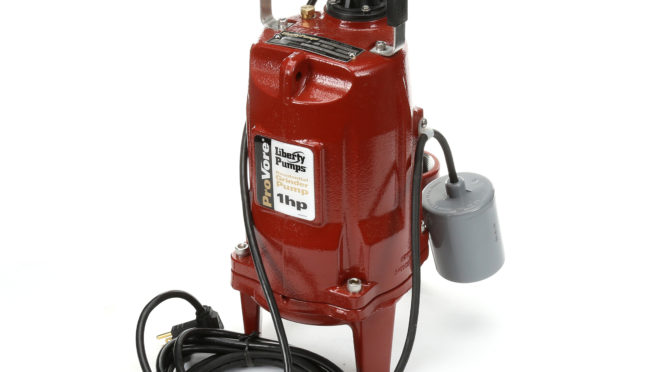We’ve reviewed a number of sewage pumps in the last year, including sewage grinder pumps and sewage ejector pumps. But what’s the difference between both kinds of pumps, and which kind is the better choice for your home or small business? We’ll answer both of these questions and more below. If you’re in a hurry, the long and short of it is that while both are designed to handle sewage (i.e., urine and feces), grinder pumps can also handle flushed trash, making them a better, though more expensive choice for crucial (e.g., commercial) situations; you can typically get away with an ejector for most residential situations.
What is a sewage ejector pump?
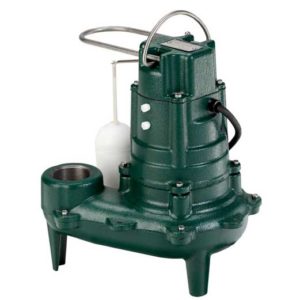 A sewage ejector pump is a submersible utility pump capable of processing solids. Essentially, it’s a beefed-up sump pump. They’re frequently described as high volume and low pressure solids handling pumps, because they can push sewage quickly but without much pressure from a home into a septic tank or a sewer main that operates by gravity flow. They don’t have grinding blades, but make use of quickly-rotating impellers that draw raw sewage vertically up and under pressure from the inlet to the outlet, which then connects to a discharge pipe.
A sewage ejector pump is a submersible utility pump capable of processing solids. Essentially, it’s a beefed-up sump pump. They’re frequently described as high volume and low pressure solids handling pumps, because they can push sewage quickly but without much pressure from a home into a septic tank or a sewer main that operates by gravity flow. They don’t have grinding blades, but make use of quickly-rotating impellers that draw raw sewage vertically up and under pressure from the inlet to the outlet, which then connects to a discharge pipe.
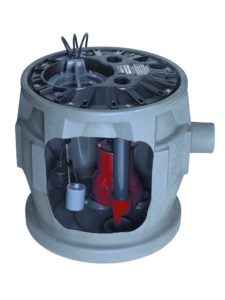 A sewage ejector pump can typically handle solids up to 2 inches in diameter, and range in power from 3/10 horsepower to 2 horsepower. They can typically pump sewage at volumes of up to 10,000 gallons per hour (166 gallons per minute) for short distances (under 700 feet) with maximum head pressures of under 30 feet. They are sold as standalone models and as pre-assembled simplex or duplex systems (which include sewage basins). Pre-assembled systems are more expensive than equivalent standalone systems, but last longer due to their design and are also simpler to install. Overall, ejector pumps are cheaper than grinder pumps, which will be discussed in detail below.
A sewage ejector pump can typically handle solids up to 2 inches in diameter, and range in power from 3/10 horsepower to 2 horsepower. They can typically pump sewage at volumes of up to 10,000 gallons per hour (166 gallons per minute) for short distances (under 700 feet) with maximum head pressures of under 30 feet. They are sold as standalone models and as pre-assembled simplex or duplex systems (which include sewage basins). Pre-assembled systems are more expensive than equivalent standalone systems, but last longer due to their design and are also simpler to install. Overall, ejector pumps are cheaper than grinder pumps, which will be discussed in detail below.
Quality examples of standalone sewage ejector pumps include the Zoeller M267 and Liberty Pumps LE51A. Quality examples of pre-assembled systems include the Liberty Pumps P382LE51 and Liberty Pumps P372LE51.
What is a sewage grinder pump?
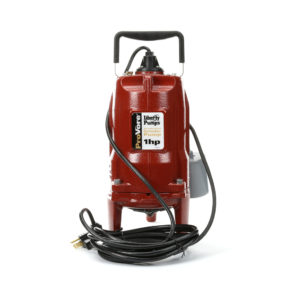 A sewage grinder pump is like an ejector pump on steroids. Like ejector pumps, they’re designed to process sewage. However, unlike ejector pumps, they also include grinding blades (hence the name) designed to grind sewage and other objects into slurry and slush before discharging it. They’re frequently described as high pressure and low volume pumps because they’ll push sewage more slowly than ejector pumps but can do it for much longer distances, to much greater heights, and can support much higher pressures at the sewer main.
A sewage grinder pump is like an ejector pump on steroids. Like ejector pumps, they’re designed to process sewage. However, unlike ejector pumps, they also include grinding blades (hence the name) designed to grind sewage and other objects into slurry and slush before discharging it. They’re frequently described as high pressure and low volume pumps because they’ll push sewage more slowly than ejector pumps but can do it for much longer distances, to much greater heights, and can support much higher pressures at the sewer main.
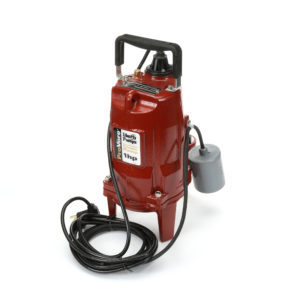 A sewage grinder pump can easily handle 2 inch solids, and will also be able to handle difficult artificial solids, like feminine hygiene products (pads, tampons, etc), rags, towels, diapers, diaper wipes, napkins, underwear, and a range of other things that shouldn’t be flushed down toilets but often are. They range in power from 1 horsepower to several, and can typically pump sewage at volumes of up to 3,000 gallons per hour (50 gallons per minute) for very long distances (multiple thousand feet) with maximum head pressures of 40 to 120 feet or more.
A sewage grinder pump can easily handle 2 inch solids, and will also be able to handle difficult artificial solids, like feminine hygiene products (pads, tampons, etc), rags, towels, diapers, diaper wipes, napkins, underwear, and a range of other things that shouldn’t be flushed down toilets but often are. They range in power from 1 horsepower to several, and can typically pump sewage at volumes of up to 3,000 gallons per hour (50 gallons per minute) for very long distances (multiple thousand feet) with maximum head pressures of 40 to 120 feet or more.
Like ejector pumps, sewage grinder pumps are sold as both standalone units and as pre-assembled simplex or duplex systems with sewage basins. As with ejector pumps, pre-assembled systems will cost more but will also last longer and be easier to install. Overall, grinder pumps are more expensive than ejector pumps, but can typically do anything an ejector pump can do with greater longevity.
Quality examples of standalone sewage grinder pumps include the Liberty Pumps PRG101A and Liberty Pumps PRG102A.
Do I need a sewage ejector or grinder pump for my septic system?
The short answer is: it depends! As you can see, both types of pumps are used for handling sewage, but while their abilities can overlap to some degree, there are clear differences between the two that make them suited to different sewage environments.
If you own a single family home that connects to a municipal sewage system (the most common configuration), you won’t need a sewage pump at all unless you have a below grade plumbing system (e.g., a toilet or shower in the basement) that can’t drain into the city sewage pipes through gravity. In such a case, a sewage ejector pump will probably get the job done (pumping sewage against gravity) just fine. You might want to install a sewage grinder pump if whoever uses that toilet (e.g., your teenage children or in-laws) regularly flush things that shouldn’t be flushed. A grinder pump will keep such things from clogging the pump impellers.
Similarly, if you own a single family home but use a septic tank (a common occurrence in rural, out in the country environments), you’ll need a sewage ejector pump at the minimum to pump sewage to the tank. As above, you might want a full-on grinder if your family members are busy using your toilets as trash cans or garbage disposals. However, unlike with the below-grade toilet that runs to the municipal sewage system, your risk of clogging will exist with any toilet in your rural home, as they’ll all feed sewage to the septic tank through the sewage pump, making the pump much more important here than with the municipal below-grade scenario. This is the point at which we’d recommend most home owners buy a grinder pump instead of an ejector pump.
If you have a home located a long distance from a gravity sewer main, if you need a lot of lift (max head), or if you need to pump sewage into a pressurized sewage system, you’ll need a grinder pump, as these are all specialties of grinder pumps.
The best sewage pumps for landlords
If you’re a landlord and have tenants in their own single-family home or duplex situation and need a sewage pump due to below-grade or septic tank scenarios, save yourself some time and install a sewage grinder pump from the start. When it’s not your family, but groups of strangers, you can’t trust them to use your sewage system the way it was intended to be used, and the first time you get a call about a clogged toilet, you’ll either have to come over yourself or get a plumber to do so, and you’ll regret not having gotten a pump that acted as a 24/7 on-call plumber ahead of time. That’s the kind of security a good grinder pump can provide. Similarly, if you need to pump sewage for a long distance to a gravity drain sewer main or to a pressurized sewer main, you’ll again want a grinder pump from the start.
Choosing a sewage pump for a small business
Finally, if you’ve got a small business (e.g.a, a restaurant, a dental office, a counseling center, an accounting or tax company) and need a sewage pump, there’s no question that you’ll want a sewage grinder pump instead of an ejector pump. Your time is your money, and your money is your livelihood; spending a few hundred extra dollars now can save you tens of thousands over the years in plumber fees, labor, and replacement ejector pumps. And again, if your business is located a significant distance from a gravity sewage main, if you need a lot of head, or if you’re pumping into a pressurized system, you’ll need a grinder pump.
You can read our reviews on a range of recommended sewage pumps here. You can buy the Liberty Pumps PRG101A grinder here on Amazon. You can buy the Zoeller M267 here.
If you find our work at PumpThatSump helpful, you can support our relentless reviewing of every sump pump on the market by shopping via our Amazon link for whatever you need to make your house a home. Despite being self-employed, we promise not to spend it all on health insurance.
